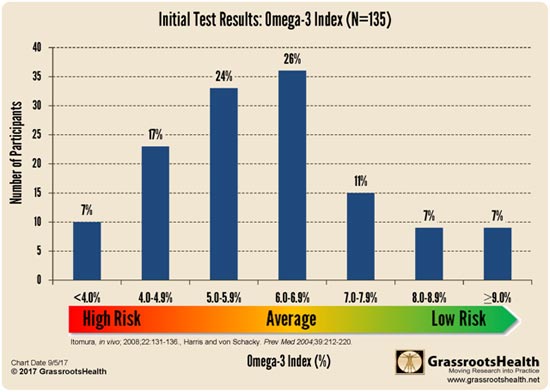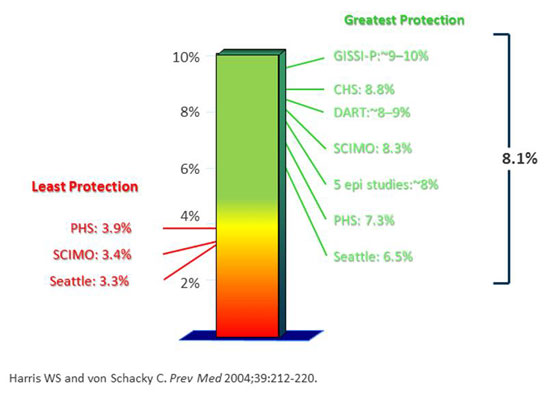Contributing writer for Wake Up World
Docosahexaenoic acid (DHA) and eicosapentaenoic acid (EPA) are long-chained omega-3 fats found in cold-water fatty fish like wild-caught Alaskan salmon, sardines, anchovies and certain other sea creatures, including krill.
[pro_ad_display_adzone id=”110028″]
Along with vitamin D testing, measuring your omega-3 level at least once a year is strongly recommended, as being low in this vital nutrient can spell trouble for your health in more ways than one.
One of the reasons why DHA and EPA are so crucial is because they’re actually key structural elements of cells; they’re not just simple fuel. If you don’t have enough DHA and EPA, your body’s ability to repair and maintain healthy cell structures is seriously impaired.
Marine-Based Omega-3 Protects Heart Health
Marine-based omega-3 is particularly important for your heart health. According to a 2016 analysis1,2 of 19 studies, higher blood levels of DHA were found to lower the risk of a fatal heart attack by 10%. This effect held true even after accounting for confounding factors like age, sex, ethnicity, diabetes and use of aspirin or cholesterol-lowering drugs.
Studies have also shown that, when taken after a heart attack, omega-3 fats can significantly improve your odds of survival.3 A large Italian trial4 found that heart attack survivors who took 1 gram of omega-3 fat per day for 3.5 years had a “clinically important and statistically significant” reduction in the risk for death, nonfatal heart attack and stroke. Animal-based omega-3 fats, especially DHA, protect and support your cardiovascular health by:5
- Lowering blood pressure and improving endothelial function
- Counteracting or preventing cardiac arrhythmia
- Lowering triglyceride concentrations
- Helping prevent thrombosis (a blood clot within a blood vessel) by decreasing platelet aggregation
- Counteracting inflammation
Most recently, results from five years of study by The North American Menopause Society (NAMS), the VITAL study (which is looking at both omega-3 and vitamin D) show fish oil supplementation lowers your risk for heart attack.6,7 Results8 were presented at the September 25 through 28, 2019, NAMS meeting in Chicago. Contemporary Clinic reported the results, noting:9
“People with dietary fish intake below the cohort median of 1.5 servings per week saw the greatest treatment benefit. Meanwhile, participants whose intake was above that level did not see as much as a benefit.”
Nutrient Requirements Could Be Met by Local Fish Catches
An interesting study10,11,12 published September 25, 2019, suggests fish is an excellent source of a variety of nutrients, including iron and zinc, and that many micronutrient deficiencies could be resolved by retaining more of the local fish catches in any given area rather than exporting them.
As reported in a press release,13 the data “showed important nutrients were readily available in the fish already being caught but they were not reaching many local populations, who were often most in need.”
In most areas of the world, a majority of fish is caught by international companies and subsequently sold to other, typically more affluent, nations, while locals often end up forgoing their native diets for processed food. As reported by SciDev.net, 90% of the fish caught in Mauritania is caught by foreign fishing fleets and never enters the local market.
In other areas, such as Namibia, even though a majority of the fishing fleets are locally owned, the fish is still exported. Edward Allison, professor at the University of Washington’s School of Marine and Environmental Affairs told SciDev.net,14 “These transformed diets suck fish towards the mouths of the better-off, meaning that not everyone who might benefit from consuming fish gets to eat it.”
Fairer Fish Trade Would Curtail Nutrient Deficiencies
For example, common nutrient deficiencies plaguing West Africa are zinc, iron and vitamin A deficiency. Yet these three nutrients are readily available in the fish caught off the West African coast, the researchers found, and in amounts sufficiently high to meet the nutritional needs of those living within 100 kilometers of the coast. As explained by the authors:15
“Micronutrient deficiencies account for an estimated one million premature deaths annually, and for some nations can reduce gross domestic product by up to 11%, highlighting the need for food policies that focus on improving nutrition rather than simply increasing the volume of food produced.
People gain nutrients from a varied diet, although fish — which are a rich source of bioavailable micronutrients that are essential to human health — are often overlooked.
A lack of understanding of the nutrient composition of most fish and how nutrient yields vary among fisheries has hindered the policy shifts that are needed to effectively harness the potential of fisheries for food and nutrition security.
Here, using the concentration of 7 nutrients in more than 350 species of marine fish, we estimate how environmental and ecological traits predict nutrient content of marine finfish species … and compare nutrient yields to the prevalence of micronutrient deficiencies in human populations …
For a number of countries in which nutrient intakes are inadequate, nutrients available in marine finfish catches exceed the dietary requirements for populations that live within 100 km of the coast, and a fraction of current landings could be particularly impactful for children under 5 years of age.
Our analyses suggest that fish-based food strategies have the potential to substantially contribute to global food and nutrition security.”
As reported by SciDev.net,16 were Namibia to retain just 9% of its local fish catches, it would resolve the nation’s iron deficiency. In Kiribati, a mere 1% of the fish catches would help resolve calcium deficiencies affecting 82% of the island nation’s population.
[pro_ad_display_adzone id=”110030″]
In conclusion, the study proposes a number of policy recommendations aimed at improving the availability of fish around the world. Among them, supporting small-scale local fisheries and implementing global fish trade guidelines to ensure fairer distribution. As noted by SciDev.net:17
“Xavier Basurto, an associate professor at the Nicholas School of the Environment at Duke University in the United States, believes that the processing of highly nutritious fish into low-nutrient products for developed countries, including pet food, should also be curtailed.
‘For instance, one could regulate certain types of catch not to be used as fish meal for export because of its nutritional value for low-income populations,’ he suggested.”
Your Blood Level, Not the Dosage, Is Key
Getting back to omega-3, data suggest deficiency in these important nutrients may be more prevalent than suspected.18 One of the reasons for this is because omega-3 testing is rather new. The assay to measure omega-3 in your red blood cells was developed by William Harris, Ph.D., in 2004. Before that, an assay was not available.
The omega-3 index is expressed as a percent of all fatty acids in the red blood cell membrane.19 Data from studies Harris performed showed an ideal, healthy range of omega-3 is between 8% and 12%.20
Importantly, the only way to determine your omega-3 status is through testing, which is now easy to do. GrassrootsHealth, a nonprofit public health research organization, has several cost-effective options available as part of its various consumer-sponsored nutrient research projects,21 the aim of which is to establish population-based recommendations based on science-backed data.
For example, ongoing research by GrassrootsHealth has firmly established that a vitamin D level of 20 ng/mL is nowhere near sufficient; the ideal range for disease prevention is actually between 60 and 80 ng/mL. Their research also shows a whopping 80% of cancer recurrences could be prevented simply by raising vitamin D to 60 ng/mL.
GrassrootsHealth is conducting the same kind of consumer-sponsored research for omega-3 and magnesium. For omega-3, you have four test options:
- Omega-3 index test kit
- Vitamin D and Omega-3 test kit
- Vitamin D, Magnesium and Omega 3 test kit
- Vitamin D, Magnesium and Omega 3 PLUS Elements test kit — This kit includes measurements of essential minerals (magnesium, selenium, zinc and copper) as well as harmful heavy metals (cadmium, lead and mercury)
Each kit contains instructions for how to collect your blood sample. You then mail in your sample and fill out a quick online health questionnaire through GrassrootsHealth.
Your participation in this research project will enable GrassrootsHealth researchers to provide accurate data about the omega-3 status in the population, the level at which disease prevention is actually obtained, and guidance on dosing to achieve optimal levels.
All of this is crucial information that can go a long way toward improving public health. Your test results will be emailed to you in about 10 to 20 days after your samples are received. Based on your index result, you will then be able to use GrassrootsHealth’s omega-3 index calculator22 to determine the dosage you may require to raise your current level to your chosen target level.
Your health data are used anonymously. Please note that 100% of the proceeds from the kits go to fund the research project. I do not charge anything extra as a distributor of these test kits.
Don’t Assume Your Intake Is Adequate
I strongly urge you to avoid the temptation to assume that your omega-3 index is sufficient just because you’re eating fish or taking a supplement. Many fish do not contain high omega-3 levels (you have to eat cold-water fatty fish to reap that benefit), and many fish oil supplements are synthetic with questionable efficacy.
As reported by GrassrootsHealth,23 of the first 135 participants in the D*action + Omega-3 home testing project, a surprising 85% had an omega-3 index below 8%, which is the lower threshold for sufficiency, putting them at increased risk for heart disease24 and other chronic diseases, as well as death from any cause.
 Source: GrassrootsHealth
Source: GrassrootsHealthAs reported by GrassrootsHealth:25
“In studies using a measurement called the Omega-3 Index test, individuals with a low Omega-3 Index were shown to have a 10-fold higher risk of death compared to those with a high index … An Omega-3 Index between 8% and 12% was associated with lower risk for death from cardiovascular disease, versus an index less than 4%.”

References:
- 1 JAMA Internal Medicine June 27, 2016;176(8):1155-1166
- 2 Medical News Today June 27, 2016
- 3 Circulation August 2, 2016; 134:378-391
- 4 Lancet 1999; 354:447-55
- 5 Circulation 2015;132:e350–e352, Table 1
- 6 Science Daily September 24, 2019
- 7 NY Post September 26, 2019
- 8 NAMS September 24, 2019 (PDF)
- 9 Contemporary Clinic September 25, 2019
- 10, 15 Nature September 25, 2019
- 11, 13 EurekAlert! September 25, 2019
- 12, 14, 16, 17 SCIDEV.net September 26, 2019
- 18, 23 GrassrootsHealth, How to Maintain Healthy Omega-3 Levels
- 19 Open Biomark J. 2008; 1: 1–6
- 20 OmegaQuant, July 9, 2018
- 21 GrassrootsHealth Research Projects
- 22 Omega-3 index calculator
- 24 GrassrootsHealth, What Are Optimal Levels of Omega-3? Why?
- 25 GrassrootsHealth, Omega-3 Call to Action
About the author:
Born and raised in the inner city of Chicago, IL, Dr. Joseph Mercola is an osteopathic physician trained in both traditional and natural medicine. Board-certified in family medicine, Dr. Mercola served as the chairman of the family medicine department at St. Alexius Medical Center for five years, and in 2012 was granted fellowship status by the American College of Nutrition (ACN).
While in practice in the late 80s, Dr. Mercola realized the drugs he was prescribing to chronically ill patients were not working. By the early 90s, he began exploring the world of natural medicine, and soon changed the way he practiced medicine.
In 1997 Dr. Mercola founded Mercola.com, which is now routinely among the top 10 health sites on the internet. His passion is to transform the traditional medical paradigm in the United States. “The existing medical establishment is responsible for killing and permanently injuring millions of Americans… You want practical health solutions without the hype, and that’s what I offer.”
Visit Mercola.com for more information, or read Dr. Mercola’s full bio and resumé here.
[pro_ad_display_adzone id=”110027″]








